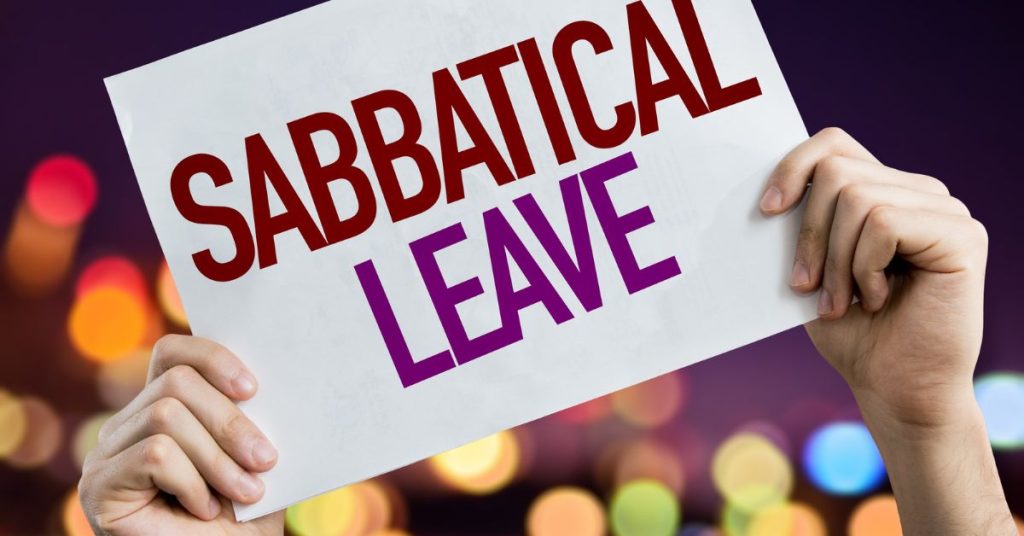Employee Sabbatical Leave: Benefits, Policies & Definition
What is a sabbatical?

A sabbatical is a term used to describe a period of time where you are able to take some time away from work. You might use it to travel, spend quality time with family, learn something new, or just relax. If you want to take a sabbatical, there are several things you need to know. First, you must make sure that you have permission from your employer. Second, you should plan ahead to ensure that you don’t lose too much money while you’re gone. Finally, you’ll need to consider how long you will be out of the office.
How long is a sabbatical?
A sabbatical is a period of time off from paid employment where you are free to pursue personal interests or projects without being penalized financially. This could mean taking some classes, volunteering, traveling or working on a side project. You might even decide to take a few days off from work entirely. A sabbatical is typically granted to employees who have worked for a certain number of years at a particular job or institution. However, it doesn’t always require tenure.
The length of a sabbatica depends on the institution or organization. At academic institutions such as colleges and universities, there are usually different levels of sabbaticals. For instance, at Stanford University, faculty members can request up to three months of unpaid leave per year. In contrast, at Harvard University, professors are allowed to spend no more than 12 months away from campus during their career.
Is a sabbatical paid or unpaid time off?
If you’re thinking about taking a sabbatical leave, it might seem like a great idea — especially if you want some extra vacation days. But what happens once you return to work? Will you still receive pay while on sabbatical? And how do companies handle this situation?
According to the Bureau of Labor Statistics, most workers don’t actually take sabbatical leaves. In fact, only 4% of full-time salaried workers took one in 2017. However, many people think that sabbaticals are paid. A recent survey conducted by CareerBuilder found that 57% of respondents believed that sabbaticals were paid. Another study published by the Society for Human Resource Management found that 52% of employers offered paid sabbaticals.
But the truth is, sabbaticals aren’t always paid. Many employers make sure that employees keep receiving pay even though they’re away from the office. This is called a “paid sabbatical leave.” An employee doesn’t lose his job because he takes a sabbatical; rather, he continues to receive pay throughout the period.
Companies typically offer flexible working arrangements for those who take sabbatials. For example, some allow employees to use accrued PTO or flex hours to cover the duration of their sabbatical. Others provide special perks such as free meals or childcare.
The bottom line is that sabbaticals aren’t necessarily paid. If you’re considering taking one, talk to your human resources department to see whether you’ll be eligible for a paid sabbatical. You could also ask HR representatives about the benefits that your employer offers.
How does a sabbatical work?
A sabbatical is usually considered a reward given to employees who are highly engaged and dedicated to their job. While it sounds like a vacation, a sabbatical actually involves working during a break from one’s career. A sabbatical is typically taken between two years and up to five years.
Your employer might agree to pay part or all of your salary while you take a sabbatical. If you don’t want to take unpaid leave, you can negotiate a paid sabbatical.
You should plan ahead before taking your sabbatical, so that you know exactly how long you’ll be gone and what you’ll do. This way, you won’t waste time searching for employment once you return.
Sabbatical leave policy
If you are thinking about taking a sabbatical year, you might be wondering how much vacation time you’ll actually receive. You could use up all of your paid time off (PTO), or you could opt for unpaid leave. Unpaid leave allows employees to take time off without losing pay, while unpaid PTO requires employers to cover the employee’s salary during the period.
The Family Medical Leave Act (FMLA) protects workers who must miss work due to serious health conditions. However, some states offer additional protections for certain types of employees. For example, California offers 12 weeks of unpaid family medical leave per year. In addition, many companies allow employees to take up to six months of unpaid leave annually.
Unpaid leave policies vary widely among different industries. Some employers require employees to use up all of their accrued PTO before they qualify for unpaid leave. Others do not count unused PTO toward the maximum number of days allowed under the policy. Still others give employees the option to use either PTO or unpaid leave.
Discussing Your Sabbatical Plans With Your Boss
Before you decide whether to take unpaid leave or use up all of your PTO, talk to your supervisor about your plans. He or she can help you determine what options are best for you and your employer. You may find that your supervisor wants to make sure you’re able to return to work in good standing. Or he or she may just want to know that you won’t be missing too much work. Either way, having a conversation with your manager about your intentions can prevent problems later on.
When discussing your sabbatical, keep in mind that it’s important to communicate your plans clearly. Be specific about why you want to take a year off, and explain why you think it’s necessary. Don’t forget to mention any special skills you’d like to develop over the course of your sabbatical. This information can help your supervisor understand why you want to take time away from the office.
What distinguishes a sabbatical from a vacation?
A sabbatical is like taking a vacation, except it’s a lot longer and you aren’t paid. Sabbaticals are often used during times of personal growth and renewal, such as when someone needs to take some time off work to reevaluate his/her life and career goals.
Sabbaticals are usually granted by employers, while vacations are typically taken by individuals. However, there are exceptions. For example, employees who volunteer for certain organizations or departments may receive sabbaticals. In addition, many companies provide sabbaticals to their executives, allowing them to spend extra time working on projects outside of the office.
Sabbatical leaves offer an opportunity for professionals to pursue education or professional training. They are generally offered to workers who want to advance their careers or enhance their skillset. While most people use sabbaticals to focus on themselves, others choose to devote their time to charitable causes or educational institutions.
Frequently Asked Questions
Is a sabbatical a good idea?
Sabbaticals are beneficial for both employers and employees. They allow employees to recharge their batteries and give them time to think about new ideas and projects. But there are some drawbacks too. Here are five things to keep in mind when taking a sabbatical.
1. When Should You Give Employees A Sabbatical?
The most important thing to consider is whether or not it makes sense for your organization. If you don’t have enough money to give your employees a sabbatical, it might not make sense to do so. On the other hand, if you’re already giving paid vacation days, you might want to offer additional days off. This way, you can encourage your team members to take advantage of the opportunity while still keeping up productivity levels.
2. How Long Does Your Employee Need To Be Off?
Another key factor is how long your employee needs to be away. Some people like to go on extended trips. Others prefer shorter breaks. For example, if someone is planning to spend six months traveling around the world, he or she could use a longer break. But if someone wants to just relax and recharge his or her batteries for a few weeks, he or she doesn’t necessarily need to travel halfway across the globe.
What are the alternatives to a sabbatical?
Taking a sabbatical is one of those things that sounds like it should be easy, but isn’t. In fact, there are many different kinds of leaves of absence – annual leave, maternity/paternity leave, bereavement leave, compassionate leave, and even a few others. But what about taking a sabbatical? What does it mean? And how do you go about deciding whether it’s something you really want to do?






